
Switzerland - Bern-Lötschberg-Simplonbahn, BLS Group + ex. RM Regionalverkehr Mittelland
For a full scale picture, please click on the picture shown !
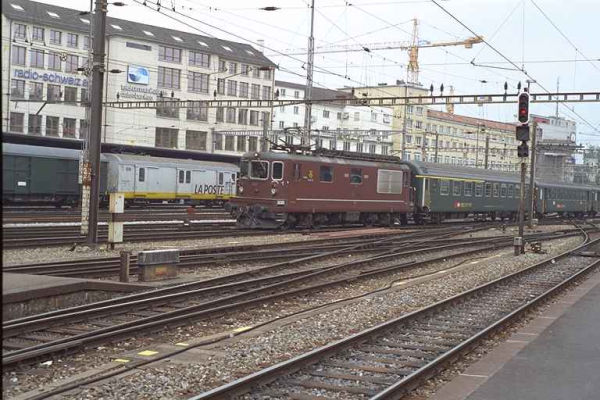
BLS AG, or as their full name is, Berner Alpenbahn Gesellschaft Bern-Lötschberg-Simplon, is one of the "big" rail companies of
Switzerland. It is privately owned, but the state SBB has a minority stake in the company. It operates trains on
almost all normal gauge and normal electricity rail lines in the country, even visiting Germany close to Basel, but their
"home ground" is the Lötschbergbahn route from Bern to Thun and Spiez close to Interlaken, then up the valley to Kandersteg and
then through the world famous Lötschberg line to Goppenstein, down to Visp and Brig in the next valley and further through
the Simplonpass to Italy, Domodossola, where it connects to the Italian line to Milano. The Lötschberg line was opened in
1913 and it was a world sensation. For example, trains make full turns inside a mountain and pass one and the same lake
three times at different elevations while climbing up the Lötschberg. But nowadays only a few trains use the old scenic route.
Most of the traffic runs under the mountains now that a new Lötschberg "basis tunnel" has been opened.
Key services of the BLS group are: 1) they run the majority of the local commuter train services ("S-Bahn") of the Bern area
and of the Solothurn to Bern area (former RM Regionalverkehr Mittelland),
2) they run a successful cars-on-train ("Rollende Landstrasse") service every 15-30 minutes through the mountain between
Goppenstein and Kandersteg (and during the summer from Domodossola to Kandersteg) and 3) they run a big and lively cargo
business in co-operation with the French SNCF to Italy. SNCF owns a part of BLS Cargo. Although the state SBB is a part owner and has
placed many of its own new locomotives in the BLS colours to operate BLS services, BLS and SBB have also
been bitter rivals for years. In 2001-02 it was announced that BLS Lötschbergbahn
stopped operating express trains and express train coaches (e.g. between Basel and Brig and Basel and Italy) and gave all their
long distance coaches over to SBB and SBB on the other hand handed over the Bern area S-Bahn operations to BLS. In 2019 the opposite
happened and BLS again started operating longer distance express trains in cooperation with SBB.
This is a BN Re 4/4 I no. 180 in Bern, 19 September 1995.
The Bern-Neuchâtel Railway BN was a part of the "Bern-Lötschberg-Simplon" group before BN became totally integrated into BLS
Lötschbergbahn. The locomotive was later known as BLS Re 4/4 or BLS Re 425 no.180.
Photo by Erik Hjelme.
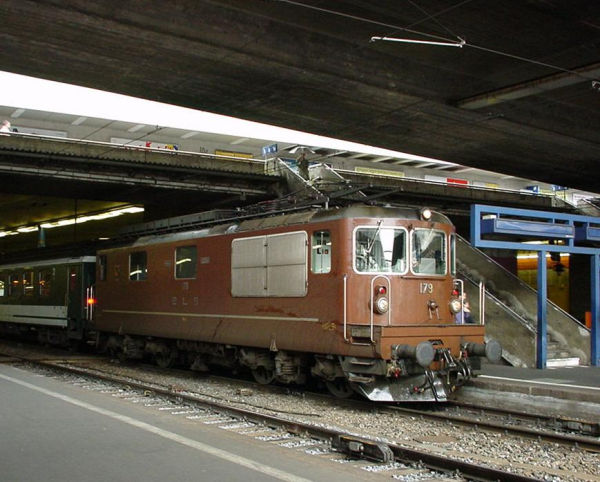
BLS Lötschbergbahn Re 4/4 locomotive no. 179 doesn´t much resemble the looks of later versions
of type Re 4/4. While the SBB was first time experimenting with direct drive electric motors on the axels,
the BLS went directly on to thyristor technology and built 35 of these - that time - quite powerful locomotives in
three series for their steep Lötschberg ramps. In fact these locomotives are among some of the very
earliest to be based on modern thyristor steered AC technology, although their looks are almost directly
from the SBB´s Re 4/4 1. series of the fourties. These BLS engines were
really ahead of their time in the seventies. The first ones were initially designated Ae 4/4 II series, but were
later renamed Re 4/4 after they received modified bogies and their top speed was accepted as 160 km/h, which of course
was adding to the vast confusion of very different locomotives with that same "name" Re 4/4.
This no. 179 is of the last BLS series, built in 1972. It is 15,47 meters long, weighs 80 tons, generates
4 990 kW of power and has a maximum speed of 125 km/h. Here it is pulling an SBB express train bound for
the BLS Lötschberg line and Italy. Usually it was mainly used with lighter passenger trains and car-on-train
"Rollende Landstrasse" services along the Lötschberg - Simplon axle.
In today´s new numbering scheme this engine is called Re 425 no. 179. (In the old numbering Re means
rapid and electric and 4/4 means that all 4 axles out of 4 deliver power. In the new numbering the first
4 indicates it´s a 4/4 series locomotive, the 2 indicates it is from second generation [number 1 would be
the Re 4/4 1. series of SBB from 1948] and the last 5 indicates the owner, the BLS group).
Photo from Bern station in June 1999 by Ilkka Siissalo.
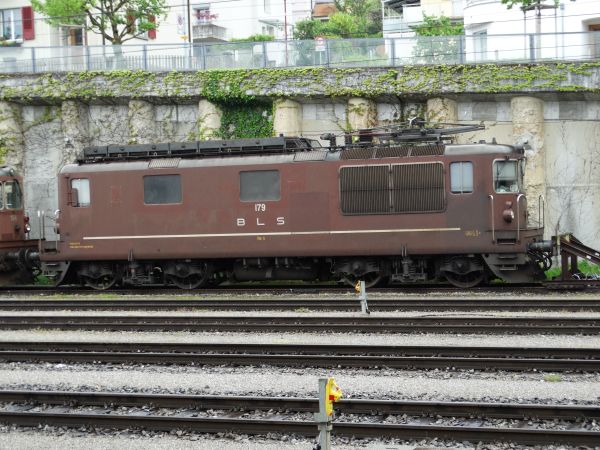
This BLS Re 4/4 alias Re 425 no.170 is one of the oldest locomotives of BLS still in use. It's one from the very
early production batches as can be seen by its old-fashioned Scheren type pantograph. In 2023 BLS still uses these
oldies in some cargo trains as well as for hauling cars through the Lötschberg tunnel between Kandersteg and Goppenstein.
Since 1995 these should be called by the new type name Re 425 but the old marking Re 4/4 is still seen on its side.
Picture is from Spiez 9.5.2023 by Ilkka Siissalo.
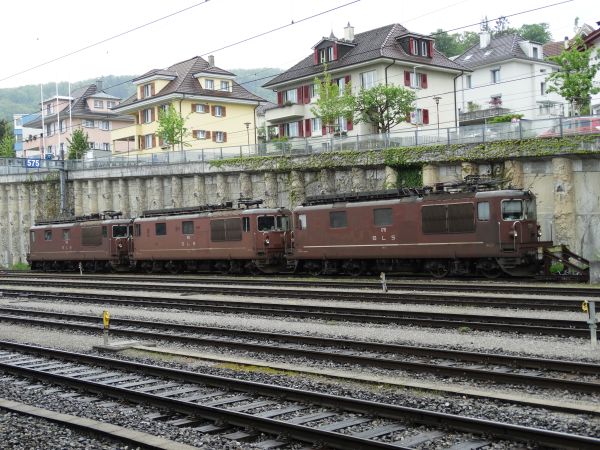
Three BLS Re 4/4 or Re 425 locomotives. The one on the right is the same one which is shown above. The two others on
the left are slightly more modern. Those are the numbers 194 and 193 from the very last series of these locomotives
built in 1982. They have already the newer Einholm type pantographs.
Picture is from Spiez 9.5.2023 by Ilkka Siissalo.
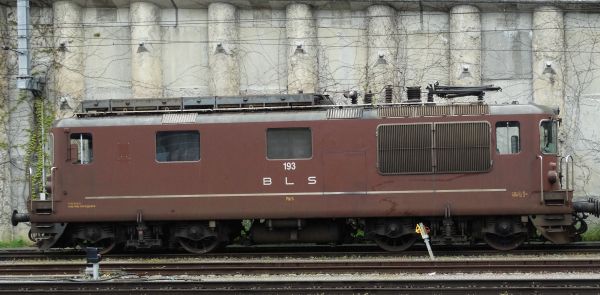
A closer look at the Re 4/4 no.193 which is the machine shown on the left in the picture above. It is from the latest
series of these machines from 1982. It was once christened as "Steg" and it carried the official emblem of the village
of Steg, but as can be seen, somebody has already stolen the emblem, leaving just a stain in the left end of the loco
showing where its name tag and emblem used to be.
Picture is from Spiez 9.5.2023 by Ilkka Siissalo.
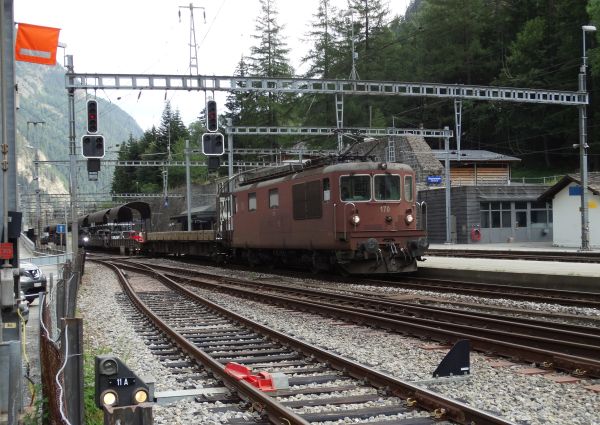
These old Re 4/4 locomotives are still used for example in hauling passenger car trains through the mountains at the
Kandersteg to Goppenstein route. Here this train has just taken a load of cars and is just about entering the long tunnel
towards Kandersteg.
Picture from Goppenstein 11.7.2023 by Ilkka Siissalo.
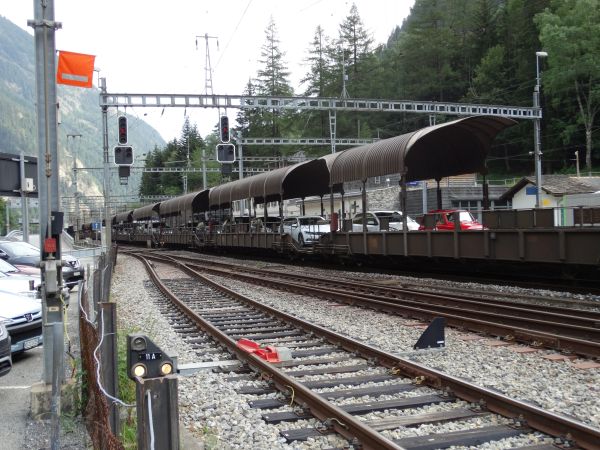
The same train as above. Now we see the long rake of car transportation wagons that the old Re 4/4 was hauling. This Lötschberg
tunnel is 14,6 km long and it takes less than 15 minutes for this car train to run through it. But it saves a lot of time for
the car drivers compared with the alternative of driving around the mountains.
Picture from Goppenstein 11.7.2023 by Ilkka Siissalo.
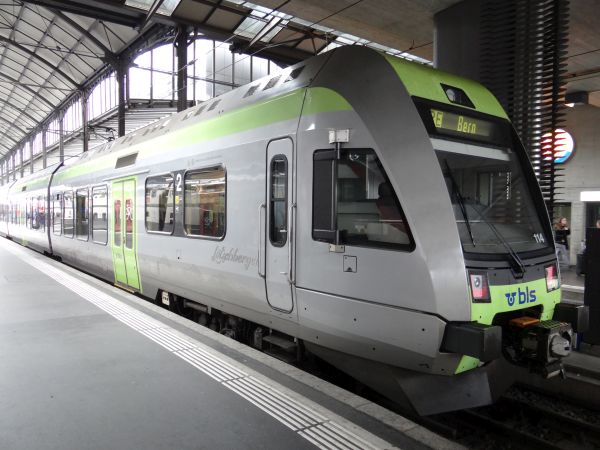
The RABe 535 "Lötschberger" is a new electric multiple unit type, which has largely superceded locomotive
pulled BLS trains on routes such as the Bern to Neuchâtel and Bern over the Lötschberg mountain pass to Brig
routes. They were built by Vevey Technologies and Bombardier at Bombardier's Swiss factories in Vevey
2008-2009. It's a 160 km/h fast EMU with a power rating of 1000 kW. There are 28 seats in first class and
143 in second class.
Picture from Luzern 1.5.2016 by Ilkka Siissalo.
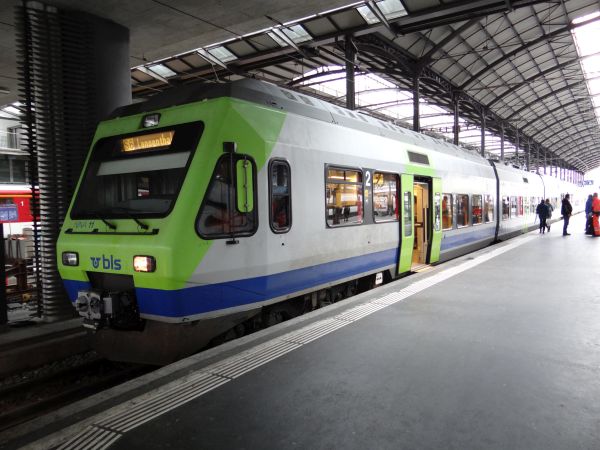
This is a so called NINA train of BLS. NINA stands for Niederflur-Nahverkehrszug or low floor commuter train. They are
actually the train class BLS RABe 525 and they were built by Bombardier, Alstom and Vevey Technologies 1998-2001.
They have mainly been used in the Bern area local commuter traffic. NINA has been a very much liked train type and
actually BLS would have wanted to buy more of them during 2007-2008, but security legislation and requirements had been changed.
The end result was the newer but similar type Lötschberger which is pictured above. NINA trains had originally 28
first class and 143 second class seats, but during renovations first class has now been removed as unnecessary in
short haul commuter traffic. Top speed of the NINA trains is 160 km/h and just like the later Lötschberger trains, they
also have a power rating of 1000 kW. NINA is 85% low-floor.
Picture from Luzern 1.5.2016 by Ilkka Siissalo.
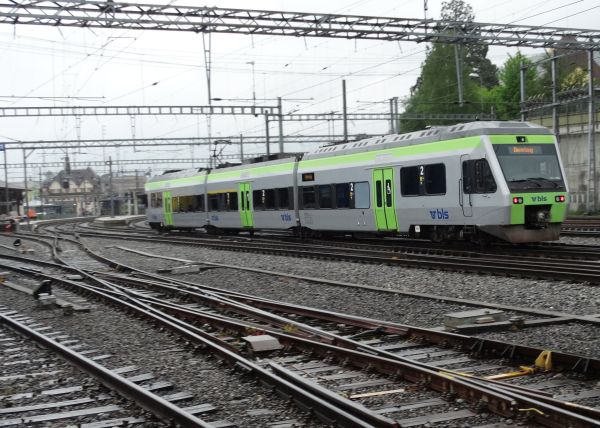
Another NINA train, now in the latest livery of BLS.
Picture from Spiez 9.5.2023 by Ilkka Siissalo.
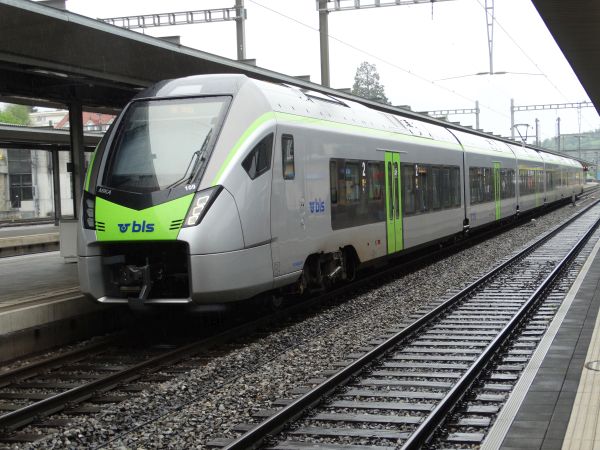
This new train type in 2023 BLS calls "MIKA". These are the newest generation FLIRT trains built by Stadler, 6 coaches long. BLS
plans to replace locomotive hauled passenger trains on longer routes such as the Bern-Neuchatel route with these now.
Picture from Spiez 9.5.2023 by Ilkka Siissalo.
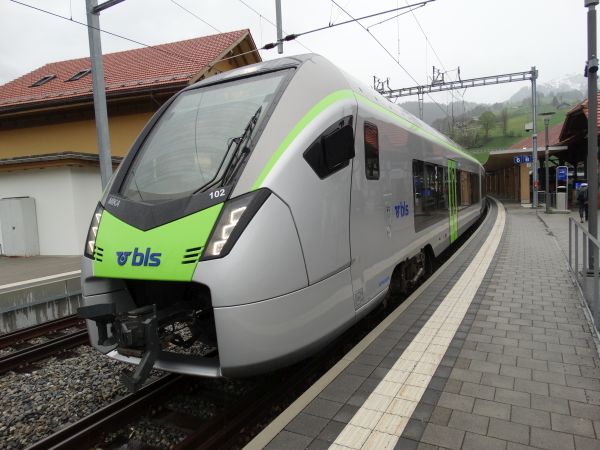
Another MIKA in Zweisimmen, operating on the prestigious Golden Pass Line touristic service between Zweisimmen and Interlaken at a time
when the use of brand new Golden Pass Express coaches on BLS' tracks was forbidden. See below for an explanation.
Picture from Zweisimmen 9.5.2023 by Ilkka Siissalo.
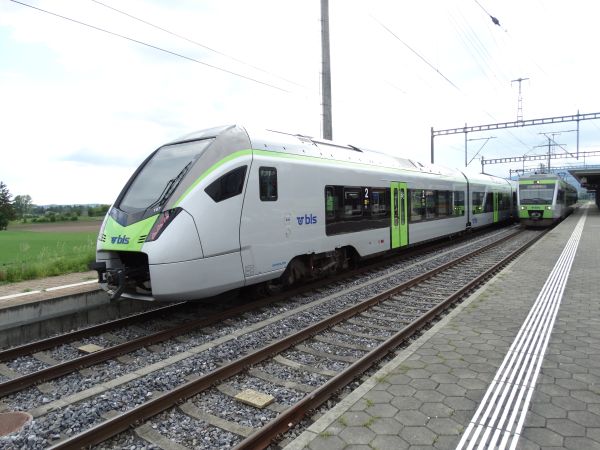
A MIKA on the left and a NINA on the right.
Picture from Ins 12.5.2023 by Ilkka Siissalo.
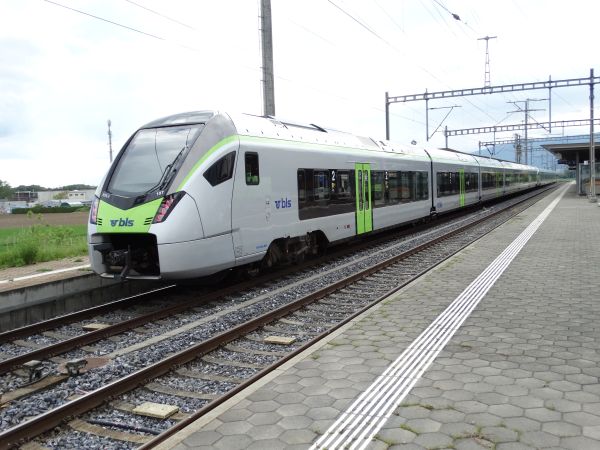
Two MIKA train units coupled together make up an impressively long train. BLS is using these compositions in the fast traffic linking the cities of
Bern and Neuchâtel.
Picture from Ins 12.5.2023 by Ilkka Siissalo.
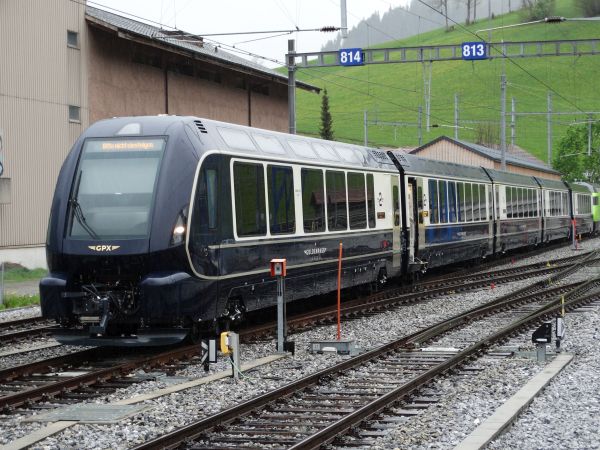
Brand new Golden Pass Express coaches in Zweisimmen. At the other end a green BLS Re 465 locomotive can be seen. These wagon sets are of a totally
new construction which can change its gauge width on which it runs between 1000mm and 1435mm. The Golden Pass line begins in the south by the Lac Leman
(Genfersee in German) at the city of Montreux. From there it climbs over the mountains with 1000 mm gauge adhesion locomotives along the track of
the company MOB, Montreaux-Oberland Bernois. For years and years tourists who are paying a hefty price for their train tickets, have had to twice
change trains on their way between Montreux and Luzern, first here in Zweisimmen, because from here to Interlaken the route continues on BLS' 1435mm
tracks. Then in Interlaken there's another change of trains, again to metre gauge of the ZB Zentralbahn. ZB uses locomotives which have a cog
wheel drive for a third rail. Now the idea was that the tourists wouldn't have to step out of their wagons any more, but the set of wagons would
modify their gauge width and only the locomotive in the front would change. This service began in the spring of 2023 afterseveral years of planning
and testing. But only after some three months of use, it was forbidden to run these variable gauge coaches on BLS' normal gauge tracks as the wagons
had a tendency to "climb up" on top of switches thereby badly damaging the tracks. This picture was taken at the time when it was already forbidden
to run these on the BLS line.
For more pictures of these Golden Pass Express variable gauge coaches, see the category Switzerland > MOB Montreux-Oberland Bernois.
Picture from Zweisimmen 9.5.2023 by Ilkka Siissalo.
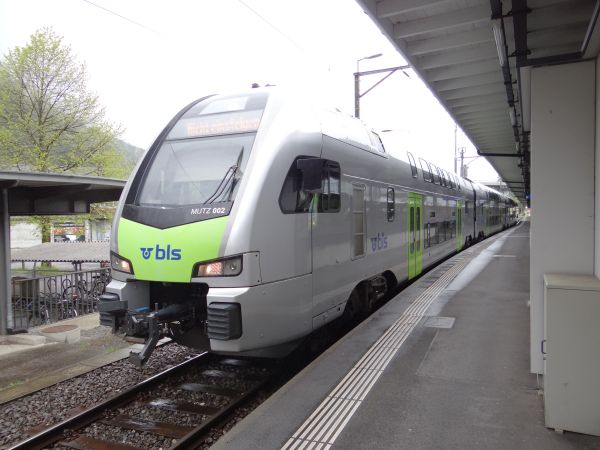
This doubledecker regional and commuter train type is made by Stadler and Stadler calls it Stadler KISS, but BLS has named its
KISSes "MUTZ". Mutz is Bernese dialect and means bear. There is a bear depicted in the emblem of the city of Bern. BLS uses these
MUTZ-trains mainly in their Bern to Interlaken traffic. According to BLS their shorthand MUTZ stands for Modern, Universal Multiple
Unit Train. Officially it is called class RABe 515. It is a fixed set of four double decker coaches and a maximum of four units
can be combined yielding a 16 coach train which can take up to 1340 people. Their maximum speed is 160 km/h. BLS plans to use MUTZ
trains also in their future longer distance express train traffic.
Picture from the station Interlaken Ost 1.5.2016 by Ilkka Siissalo.
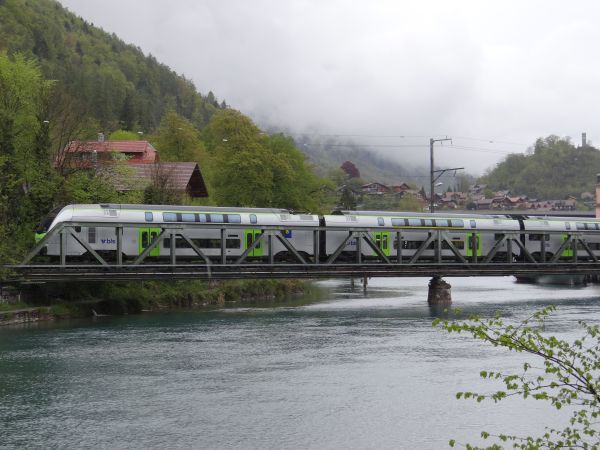
A BLS MUTZ train is crossing a river quite next to the station of Interlaken Ost.
Picture from the station Interlaken Ost 1.5.2016 by Ilkka Siissalo.
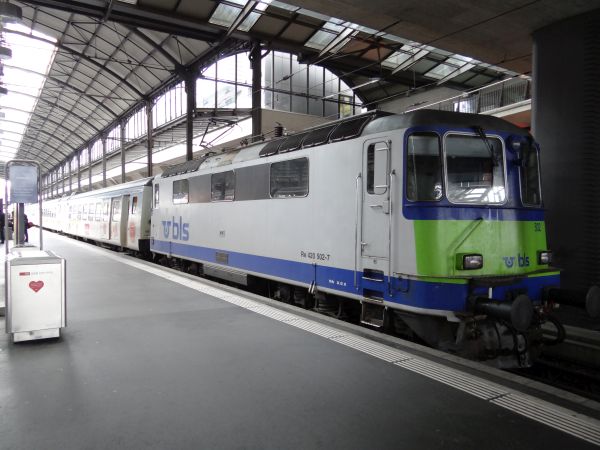
In 2004 BLS bought from the Swiss federal railways SBB used so called Swiss Express trains consisting of sets of EW III
(Einheitswagen III, standard coach III) and locomotives of the type Re 4/4 II. BLS renamed the locomotives to Re 420.
This is one of those locomotives and coach sets. This coach set was taped with advertisement tapings of the biscuit
factory Kambly and therefore this one train got the nickname "Kambly-Zug". There were even H0 scale model trains made of this train.
Picture from Luzern 1.5.2016 by Ilkka Siissalo.
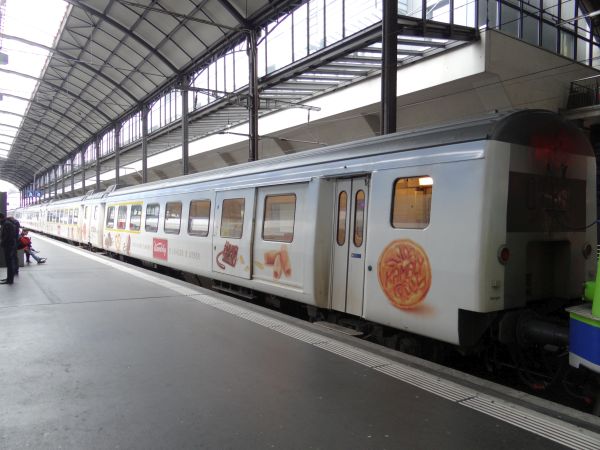
The "Kambly-Zug" or set of EW III coaches of BLS all covered with advertisements of biscuits made by the biscuit factory Kambly.
Picture from Luzern 1.5.2016 by Ilkka Siissalo.
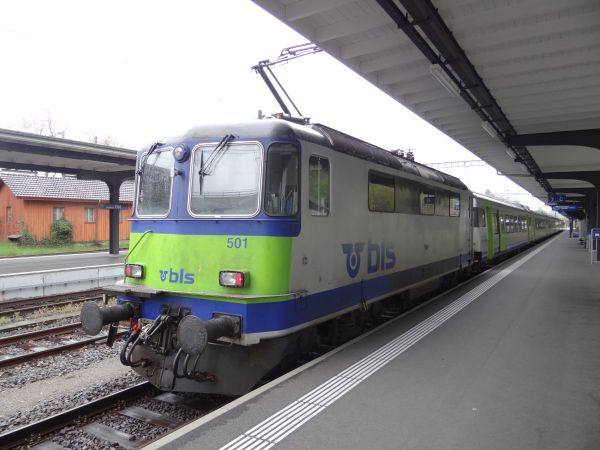
A similar train like the one pictured above, composed of one old Re 420 locomotive and a fixed rake of EW III coaches, but this time in BLS'
regular livery and not in a biscuit company advertisement painting as above. When these same trains were still used at the federal railways
SBB these trains used to be called Swiss Express and they were painted orange and creme.
Picture from Interlaken Ost station 1.5.2016 by Ilkka Siissalo.
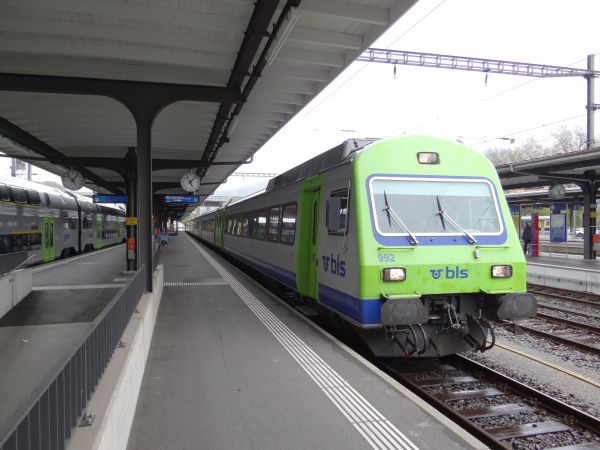
Same train as above, but seen from the other side. This is the steering cab coach of a former Swiss Express train (EW III coach).
Picture from Interlaken Ost station 1.5.2016 by Ilkka Siissalo.
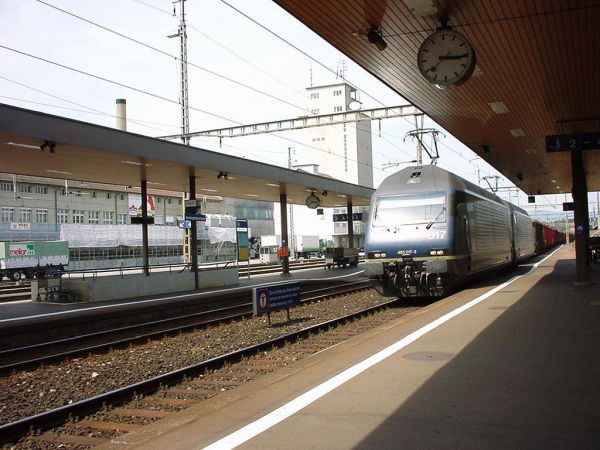
Extremely heavy cargo train led by two BLS Re 465 locomotives in full speed between Basel and Bern,
a fraction of a second before passing the photographer, on the way to the Simplon line and south to
Italy. The Re 465 is a modification of the Re 460, the so called "Lok 2000", the former pride of Switzerland.
Re 465 is 18,5 metres long, weighs 84 tons and has a maximum speed of "only" 230 km/h. Difference
between the original Lok 2000 alias SBB`s Re 460 and the Re 465 is that the 465 has been adapted for use
on the extremely steep slopes of the Simplon mountain line; therefore it is slower but stronger. The
company BLS, Bern-Lötschberg-Simplonbahn, has 8 of its own of these blue beauties and in addition to
that the state SBB, part owner of BLS, bought 1996-97 a further ten (numbers 009-018; so this one we
see here is actually an SBB locomotive) and painted them in the blue colours of the BLS. The original painting
of the Lok 2000 is bright red, as seen at the SBB Re 460s. Matter of taste, but I find the BLS blue more
attractive. The stylish design of the locomotive is from the famous Italian design company Pininfarina.
The picture actually shows a modern paradox: an SBB locomotive in "enemy colours" pulling a cargo train
for the competitor of SBB. This is a typical train pulled from Germany with BLS engines all the
way through the Simplon pass.
For a picture of the exact same locomotive in its new paintings in 2023 scroll down a bit.
Photo from Herzogenbuchsee station in October 1999 by Ilkka Siissalo.
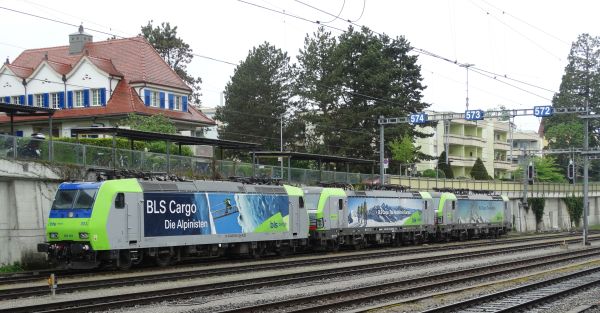
Three BLS Cargo locomotives waiting for their next task. The one on the left is an Re 485 Bombardier TRAXX on their second generation.
The two others are a bit newer Siemens Vectron Re 475 machines.
Picture from Spiez 9.5.2023 by Ilkka Siissalo.
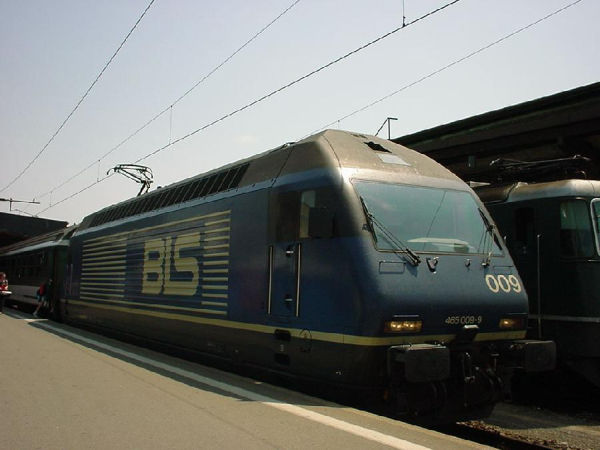
Re 465 no. 9 of the BLS, Bern-Lötschberg-Simplonbahn at Zürich Hauptbahnhof station ready to take an SBB passenger train
across the Alps to Italy. The Re 465 is otherwise the same "Lok 2000" locomotive as the Swiss national railroad SBB´s famous
Re 460, except that it has been slightly modified for slower speed ("only" 230 km/h) and higher power (7000 kW vs. 6100 of the
SBB Re 460) for use at the Lötschberg mountain line. The first series, numbers 1 to 8, were built in 1994. This one no.
9, belongs to the second series, no. 9-18, built in 1996 and actually is not owned by the BLS but by the SBB, despite the BLS
paintings. SBB ordered these engines for the so called NEAT transito traffic along the Lötschberg - Simplon - Italy
mountain line, but lets BLS operate and maintain the engines.
Picture from Zürich in June 1999 by Ilkka Siissalo.
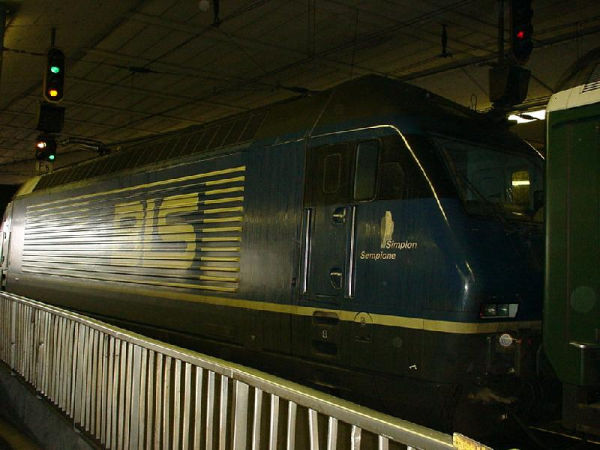
Glistening from rain, the BLS Lötschbergbahn Re 465 locomotive "Simplon" has just led an SBB express train from the other side
of the Alps to the Bern station. Now it´s time for the state SBB to put their own locomotive once again in front of their train
while "Simplon" will lead another train back to the Lötschberg tunnels and - Simplon. The picture shows well the famous Italian
Pininfarina design of the "Lok 2000" engine. Basically the same engines have also been exported, most notably to Norway and to
Finland. German DB was also highly interested, but opted instead to create a new design themselves because of "the astronomic costs
of the Swiss engine": about 3 times the cost of their Br 101, which made it "impossible to afford such luxury". Their cheaper
design became the Br 101, which still today is the main locomotive on long-haul IC and EC trains in Germany.
Photo from Bern 1999 by Ilkka Siissalo.
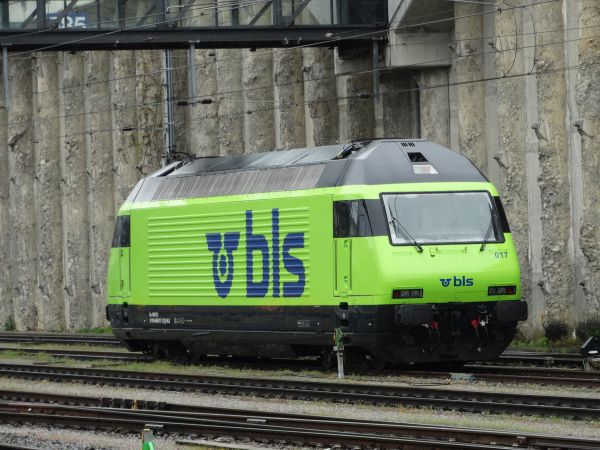
This is the latest painting livery of these Re 465 locomotives. In the meantime many of them were rented to the cargo company
railCare AG and during that time they were all white with individual names and large pictures on their sides by railCare. But
after the leasing agreement ended they are now being all painted in this latest BLS painting style.
Picture from Spiez 9.5.2023 by Ilkka Siissalo.
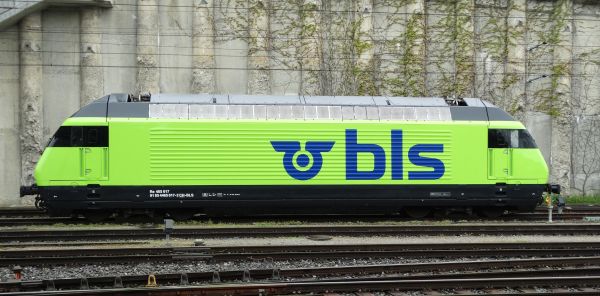
A side view of the BLS Re 465 no.017.
Picture from Spiez 9.5.2023 by Ilkka Siissalo.
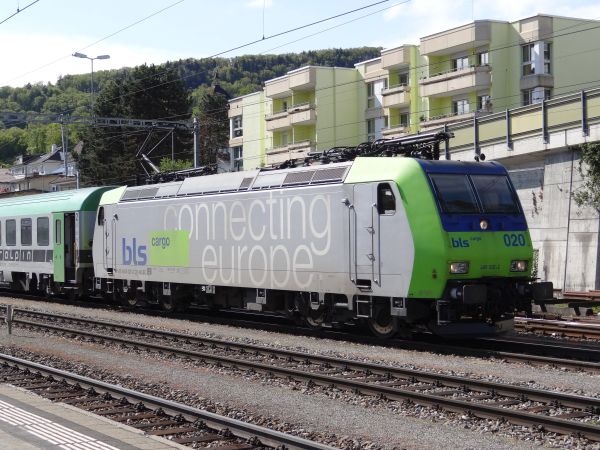
A typical locomotive of BLS Cargo today, this is the Re 485 (equal to Br 185 of Germany). It is a Bombardier TRAXX MS multiple
electric systems locomotive, which can - at least in theory - pull a train all the way for example from Holland via Germany and Switzerland
right into Italy. BLS uses nowadays many TRAXX family machines.
Picture from Spiez 2.5.2016 by Ilkka Siissalo.
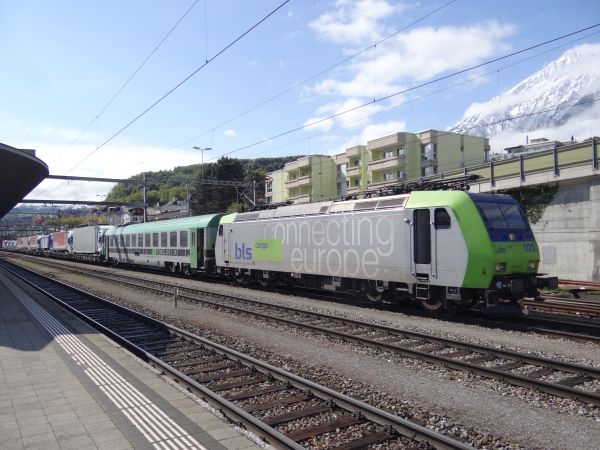
The same train as above. It is here leading a "Rollende Landstrasse" (rolling highway) service bringing lorries from Italy over the Alps to Germany.
Lorry drivers can rest in the attached sleeperette coach while their trucks are being hauled over the Alps - or rather, under the Alps, as it most often is today.
Picture from Spiez 2.5.2016 by Ilkka Siissalo.
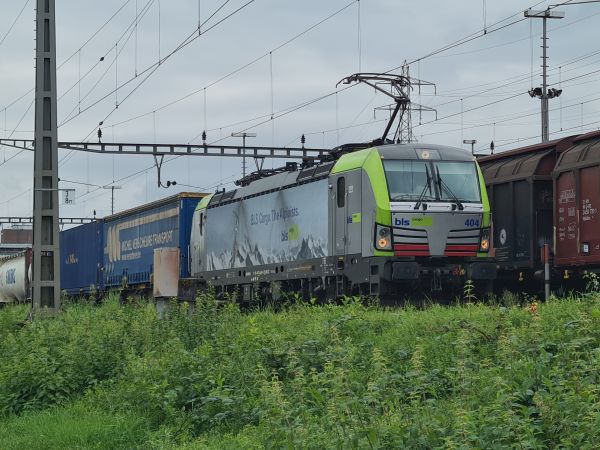
This is a Siemens Vectron locomotive of BLS Cargo. BlS has bought 50 of them in two batches and then on top of that BLS also
has some rented Vectron machines. In Germany these are registered as Baureihe 193 but in Swiss register this type is called Re 475.
Picture from the Muttenz shunting yard close to Basel 5.11.2022 by Ilkka Siissalo.
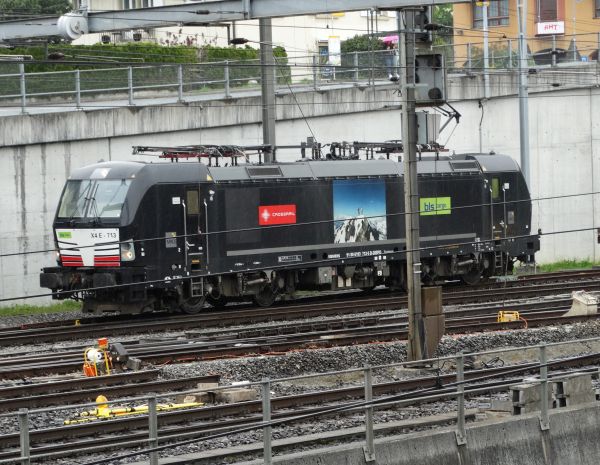
Crossrail used to be an independent Swiss cargo operator with a subsidiary in the Netherlands. After many changes, Crossrail is now a fully
owned subsidiary of BLS Cargo, which mainly runs cargo trains from the harbours of Holland to Germany. This rented Siemens Vectron has now the
logos of both Crossrail and BLS Cargo. This machine can haul trains all the way from Holland via Germany and Switzerland to Italy. The black
colour and the small silvery logo in its front part tells us that the owner of the machine is the company MRCE Dispolok.
Picture from Spiez 9.5.2023 by Ilkka Siissalo.
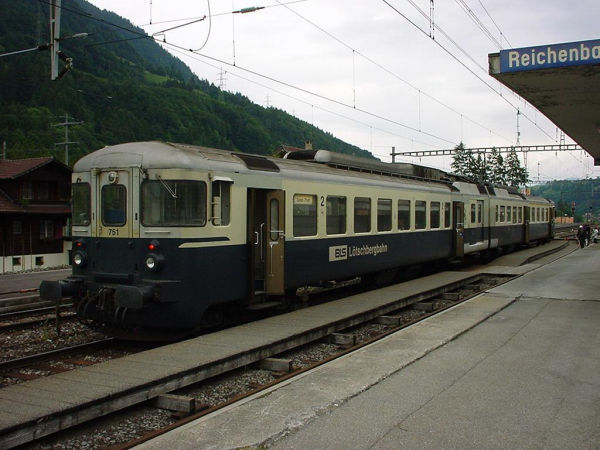
This ABDe 4/8 number 751 of the BLS Lötschbergbahn is the first one built in 1964, in the third series of similar
trains. The first series was built in 1945 (see the pictures from Önsingen-Balsthal-Bahn OeBB ABDe 4/8),
the second series in 1954 to -57. Ten years later BLS ordered a further four of almost exactly similar short distance
commuter trains. The trains were designed for S-Bahn local commuter traffic around the capital, Bern. This third
series from the sixties differs from the earlier ones by a "newer" front design which resembles the Re 4/4
locomotives of BLS of that time (see bls-re425-179.jpg). The electrical parts of these trains were modernised
in 1977, which allowed for a higher maximum speed of 125 km/h.
The two-coach unit is 46,8 metres long, weighs
102 tons (sic! - _thick_ iron!), but generates a modest 1180 kW of power. The original ABDe 4/8 pair was designed
in 1945. The idea was that these pairs could form trains which could be used for through-the-Alps traffic all
the way to Italy. This was however never realised and the trains have been in valley line traffic around Bern.
The very last trains of this kind were still in use on less-than-important local commuter routes like here between Reichenbach
and Thun in 1999.
Photo from Reichenbach station in June 1999 by Ilkka Siissalo.
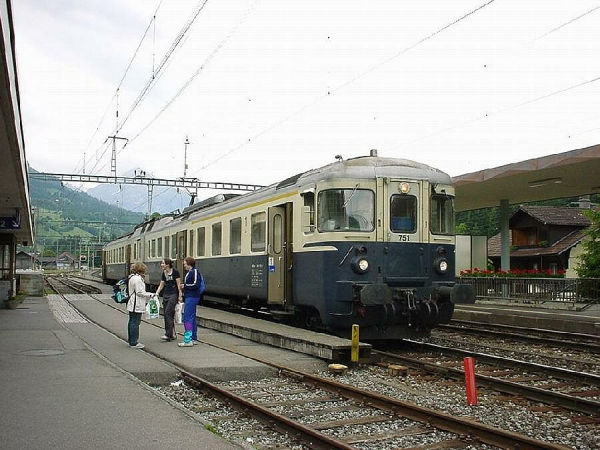
Another view of the BLS Lötschbergbahn ABDe 4/8 no 751. This electric motor unit was a fixed two coach pair. The electric
systems of these trains were built in 1964 and renewed in 1977, raising the maximum speed to 125 km/h. From three different
series, there are 13 of these pairs, 10 of which were in 1999 still operating under the blue-white colours of the BLS.
Three pairs of the oldest series from 1945 were already in 1999 sold to two other private railroads, OeBB and RVT. Originally,
the trains were designed in the fourties to be retrofitted with a second drive system to accommodate also the differing voltage
in Italy in order to allow short-haul passenger trains of this type to pass through all the way through to Domodossola in Italy.
This plan was never realised, but it explains why there is plenty of empty space on the roof to accommodate a second pantograph and
coolers.
Photo from Reichenbach station in June 1999 by Ilkka Siissalo.
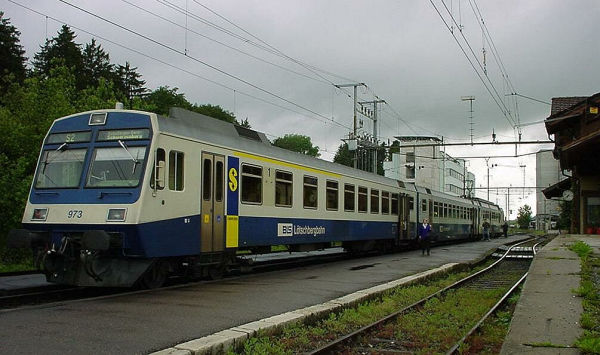
The RBDe 4/4 (or with the new numbering scheme RBDe 565) was built in three series between 1982 and 1991. It is still today used
in BLS´s short haul services, especially in the S-Bahn network around the capital Bern. It is very similar to
the RBDe 560 of the state SBB and in fact almost 1:1 identical with the prototype series of SBB´s trains, named NPZ or Neue
Pendelzug (new pendeling train). Still in the nineties similar or almost similar trains took care of the majority of traffic on other
private companies networks as well, such as EBT, GFM and RVT/Regionalverkehr Mittelland, SüdOstBahn, Bodensee-Toggenburgbahn,
MittelThurgauBahn and others. BLS had 22 of these units. Just like SBB also BLS later retrofitted old aluminium express train
coaches of the EW series ("Einheitswagen" - a similar coach used by the majority of Swiss companies) to be used as extra
coaches in the middle of the originally two-car units, but BLS and some other companies also later ordered middle coaches to
exactly fit into the look and feel of the NPZ trains. This picture shows one of those later "tailor-made" middle wagons. The
original two-coach unit is 25 metres long, weighs 69 tonnes, has a maximum speed of 125 km/h and generates 1700 kW of power.
Photo of the "S2" line S-Bahn of Bern close to the station of Belp in June 1999 by Ilkka Siissalo.
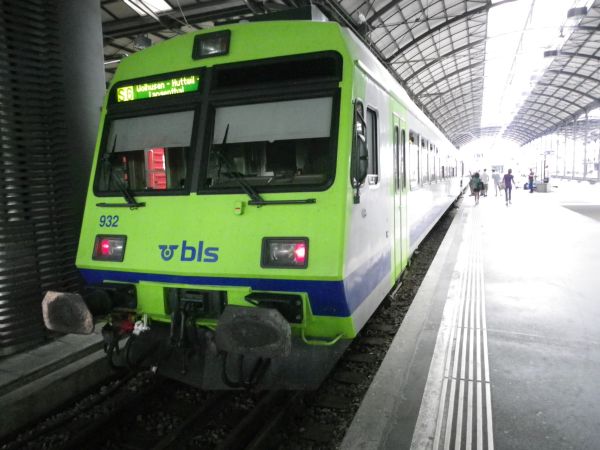
This BLS RBDe 565 no.932 is exactly similar with the train shown above, except that this one has been modernised and painted in BLS'
newest colours. However, soon these will all be history. BLS informed in 2022 that it wants to get rid of all of these old NPZ trains.
Picture from Luzern 10.7.2010 by Ilkka Siissalo.
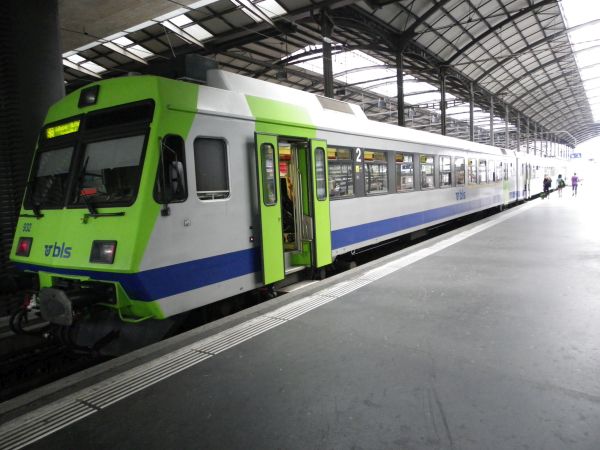
Side view of the same BLS RBDe 565 no.932 as shown above.
Picture from Luzern 10.7.2010 by Ilkka Siissalo.
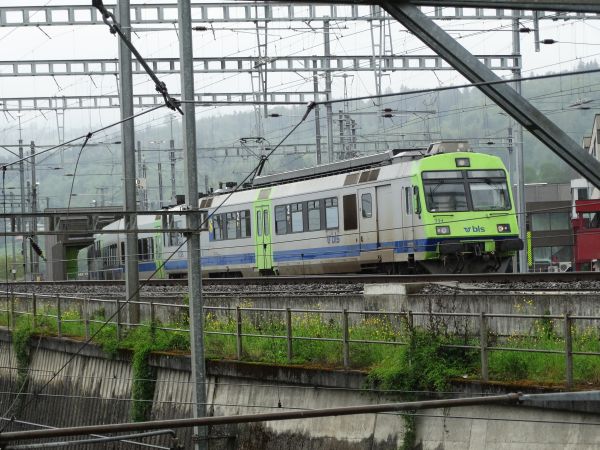
Here we see one of the "Neue Pendelzug" or RBDe 565 trains, similar to the ones shown above, just arriving at the station of Spiez.
But this picture also somewhat shows the later added low-floor middle coaches in the middle of the train. They look quite odd as they
are so different from the rest of the train.
Picture from Spiez 9.5.2023 by Ilkka Siissalo.
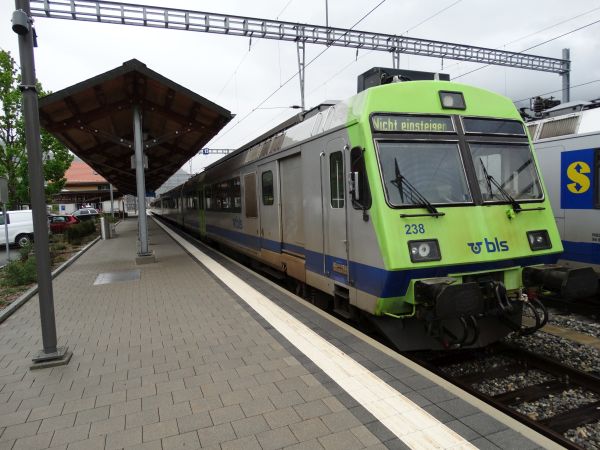
One more RBDe 565 train. Here the train has extra middle coaches, but they are not those relatively new low-floor coaches as in the picture above.
Here the whole train is more or less of the same age.
Picture from Zweisimmen 9.5.2023 by Ilkka Siissalo.
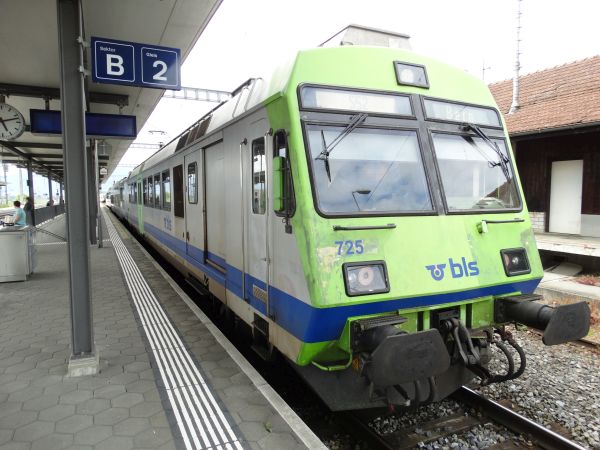
Still one more RBDe 565 train, this time again with a much newer low-floor middle coach built by Stadler.
Picture from Ins 12.5.2023 by Ilkka Siissalo.
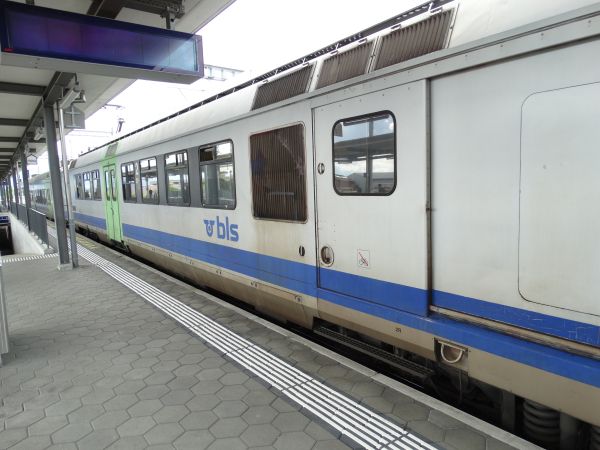
This is the same RBDe 565 train as shown above and here we see the cargo compartment which gives the letter "D" in the train's naming.
(R=rapid, B=second class, D=with cargo compartment, e=electric)
Picture from Ins 12.5.2023 by Ilkka Siissalo.
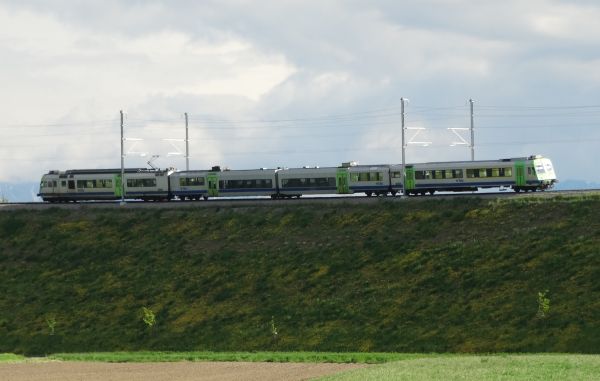
A fairly new Swiss law says that all trains, trams and buses should be legally speaking accessible, meaning that they should have at least
some part which is low-floor. To keep its old RBDe 565 trains legal and running still for a while, BLS ordered new middle coaches which
are low-floor. They were made by Stadler. They are a two coach fixed pair with a Jacobs bogie in between. The new middle coaches are also
airconditioned. The old RBDe 565 coaches are not, but the drivers' cabs have now been retrofitted with small AC machines on top of the roofs.
Picture from near Ins 12.5.2023 by Ilkka Siissalo.
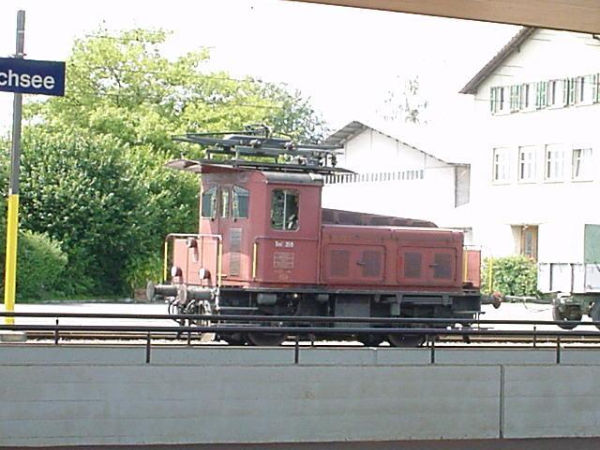
Every major station used to have its own permanently stationed locomotive in Switzerland in reserve and for switching work - a luxury
which was standard practise there, but almost nobody elsewhere could afford. This means that the country was full of very small, most
often electric locomotives, most of which were officially classified as rail tractors. All of them were used very seldom. This example, Tm 215 of the BLS
Lötschbergbahn is a rarity - BLS only has this one - but almost exactly similar new locomotives were still built in the
beginning of the 1990s for other companies. For example the state SBB had over 200 of the Tm II series engines which looked
very similar to this one. This BLS Te 215 from 1925 (modernised 1956) was 8,13 m long, weighed 36 tons and had a maximum speed
of 50 km/h.
Photo from 1999 from Herzogenbuchsee by Ilkka Siissalo.
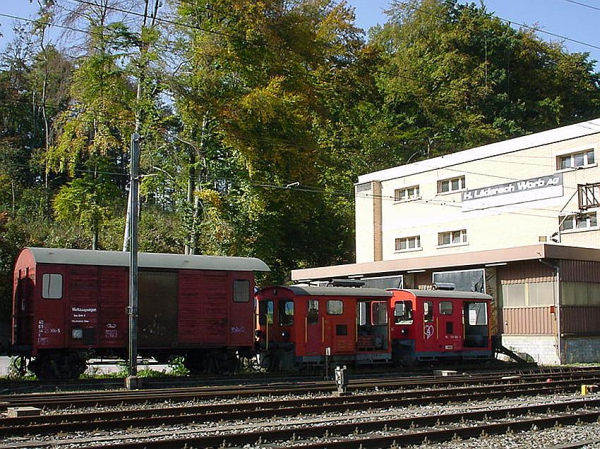
Two "rail tractors" or small helper locomotives of the type Tm 235 of the BLS Bern-Lötschberg-Simplonbahn. The
one in the middle, number 70, shows the original painting from years 1962-75, whereas the one on the right,
number 68, has undergone a total revision during 1993-95 and is now painted bright red. These small ones weigh
9,1 tons, they are 5,24 m long and they can pull a couple of coaches at speeds up to 45 km/h with their tiny
diesel engines.
Photo on 15.10.2001 from Bern-Weissenbühl station by Ilkka Siissalo.
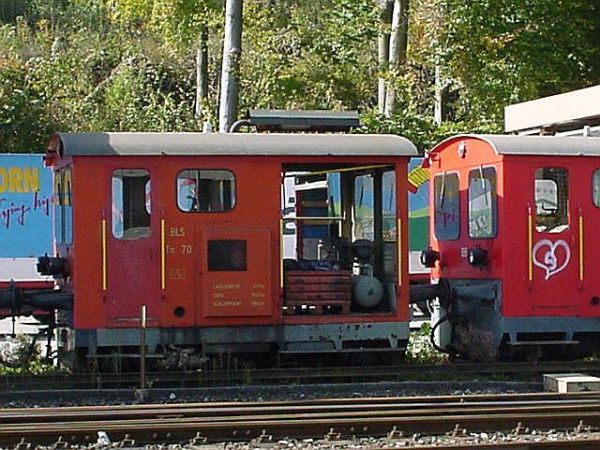
Closeup of the Tm alias Tm 235 (according to a new numbering scheme) of the BLS, in the original state of the
sixties, having undergone no revision. In Switzerland it is the habit that almost every station, no matter
how small, had at least one small locomotive or "rail tractor" - as the smallest are usually called - always
present, just in case. They are rarely used and even when they are, it is just a matter of moving or switching
a wagon or two. The state railroad SBB usually has a bit bigger electric locomotives for this purpose, whereas
private companies such as the BLS have settled for something as small as one can get. Very few other countries can
afford keeping tens of locomotives on every station just standing still, for just-in-case. And even in Switzerland
the numbers of these small helper locomotives are now rapidly falling.
Photo on 15.10.2001 from Bern-Weissenbühl station by Ilkka Siissalo.
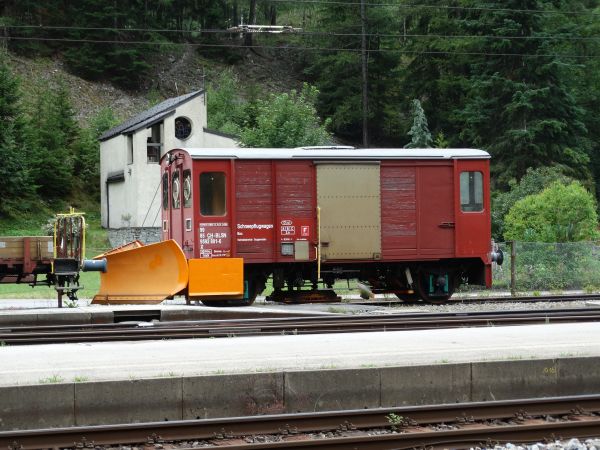
Formerly a cargo wagon, now a snow plough. Note under the wagon the hydraulic machinery which allows the wagon to clean
tracks by wiping them. This is especially useful in the autumn for wiping slippery rotten leaves away.
Picture from Goppenstein 11.7.2023 by Ilkka Siissalo.
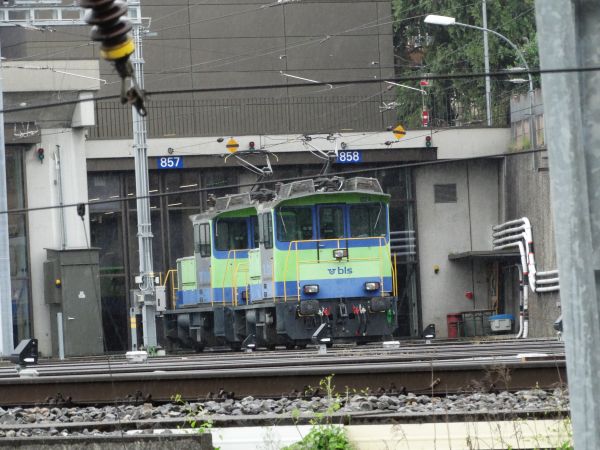
Two relatively new electric shunter locomotives, or as BLS calls them, electric tractors. These are of the type Tea 245.
Photo on 9.5.2023 from BLS' depot in Spiez by Ilkka Siissalo.
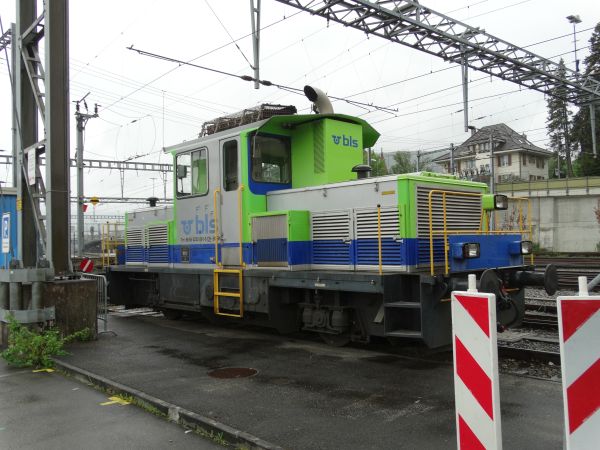
Not all of BLS' locomotives are electric. This small diesel of the type Tm 235 belongs to BLSN or BLS Netz, the track maintenance part
of BLS group.
Picture from Spiez 9.5.2023 by Ilkka Siissalo.
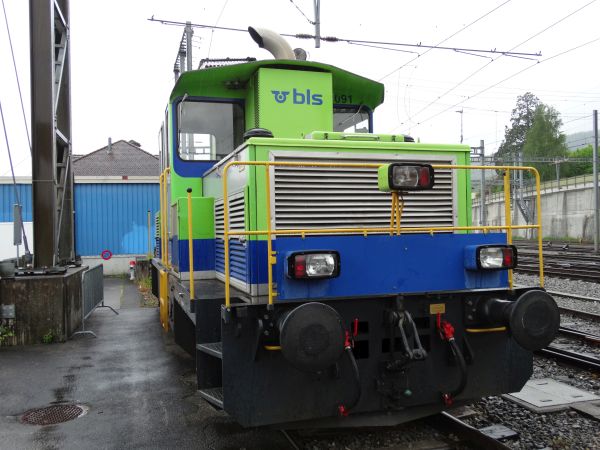
The same Tm 235 as above but now seen from its front.
Picture from Spiez 9.5.2023 by Ilkka Siissalo.
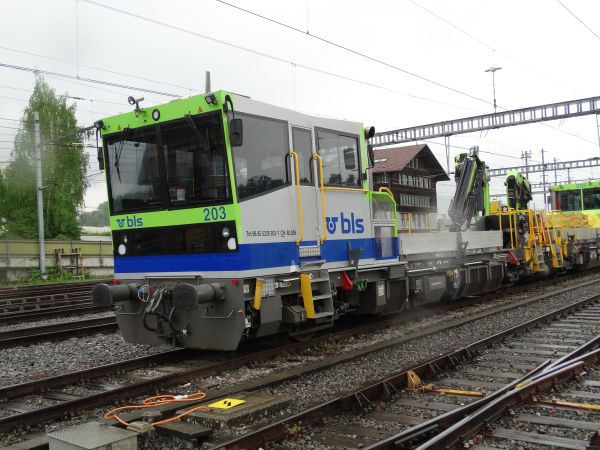
This one is also marked as Tm 235 of BLSN, but it is a very different machine. This is a rail truck made by the company Robel. These are mainly used
for bringing sleepers to a construction site.
Picture from Spiez 9.5.2023 by Ilkka Siissalo.
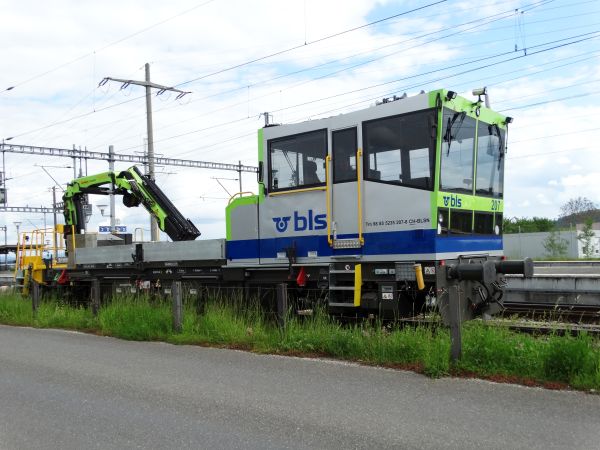
Another Tm 235 of BLSN made by Robel.
Picture from Ins 12.5.2023 by Ilkka Siissalo.
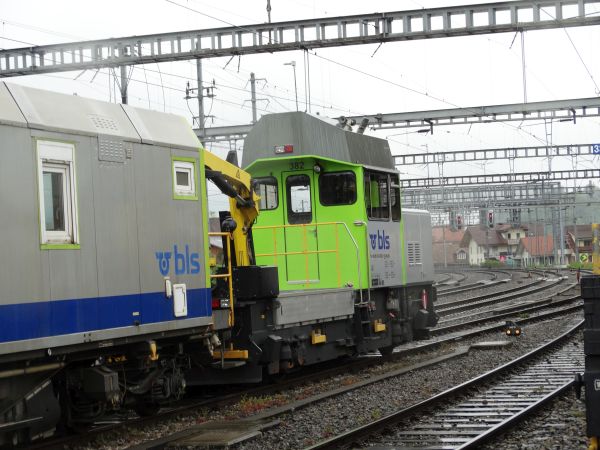
A different kind of a rail truck, this is the BLSN Tm 234.
Picture from Spiez 9.5.2023 by Ilkka Siissalo.
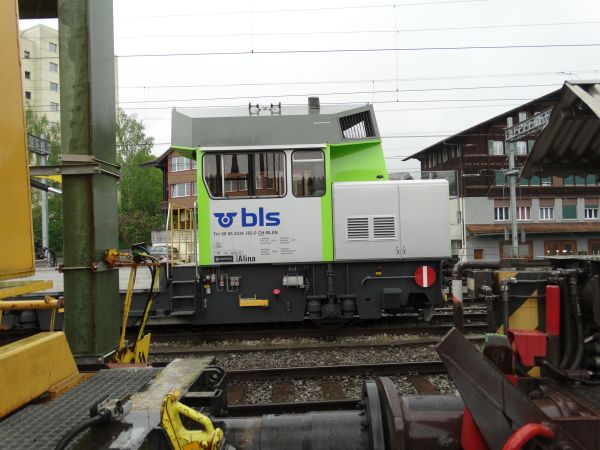
Side view of the same Tm 234 as shown above. This individual has been named "Alina".
Picture from Spiez 9.5.2023 by Ilkka Siissalo.
The former RM Regionalverkehr Mittelland
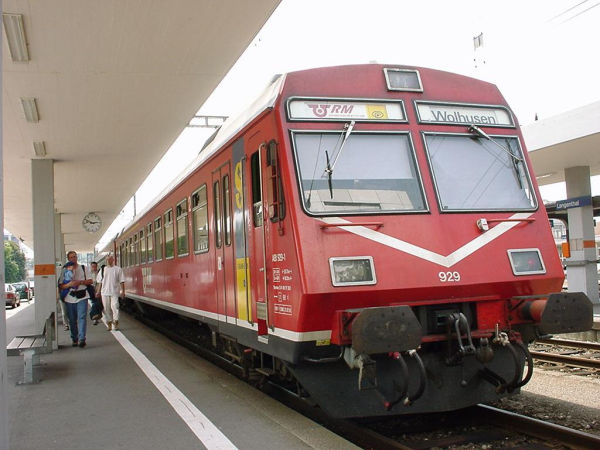
RM or Regionalverkehr Mittelland was a private company that took care of both local passenger and cargo traffic east and north
of the city of Bern. RM operated on normal gauge 15 kV 16,7 Hz electricity just like the federal railways and the networks of
RM and the federal SBB partly overlapped. RM used to have around 1999-2001 16 electric and 2 steam locomotives, around 30 rail tractors
and numerous EMUs. RM used to be one of the largest private rail companies in Switzerland. It had its headquarters in Burgdorf.
RM itself was the fusion product of altogether nine former rail companies: Emmentalbahn EB, Burgdorf-Thun-Bahn BTB, Langenthal-Huttwil-Bahn
LHB, Huttwil-Wolhusen-Bahn HWB, Ramsei-Sumiswald-Huttwil-Bahn RSHB, Solothurn-Münster-Bahn SMB, Huttwil-Eriswil-Bahn HEB, Emmental-Burgdorf-Thun-Bahn
EBT and Vereinigte Huttwil-Bahnen VHB. As a company RM was established 1.1.1997 and dissolved by fusion into the BLS group in 2006.
This train was one of RM's so called NPZ or Neue Pendelzug trains, new pendeling train of the class RBDe 566, formerly EBT's RBDe 4/4 II. In front in
the picture is the motorless steering cab coach Abt 929 of the train. These trains were built first in 1973-74 and more similar ones in 1984-85.
Compare with the picture of a similar one in BLS' blue and creme livery higher up on this same page.
This picture is from Langenthal 15.10.2001 by Ilkka Siissalo.
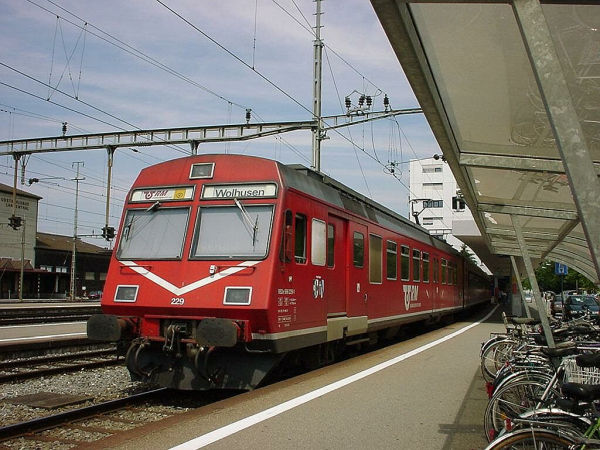
The other end of the same train as above. RM's NPZ trains consisted of two coaches, one motorised and one unmotorised steerig cab coach. This one was
the motorised wagon, RBDe 566 II no.229 from the year 1984.
This picture is from Langenthal 15.10.2001 by Ilkka Siissalo.
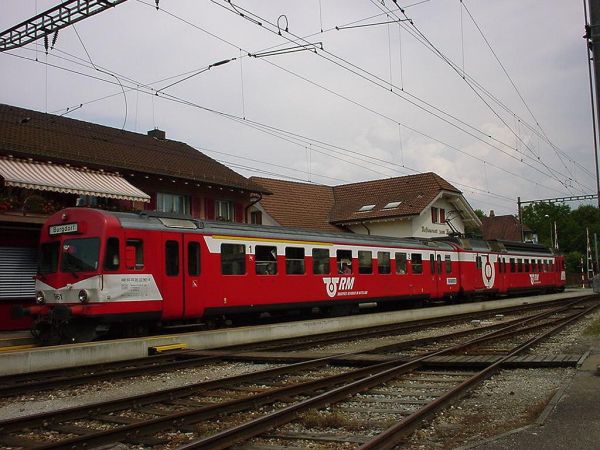
This train is Regionalverkehr Mittelland's RBDe 566 I, a train which can be seen as kind of an early prototype of the later
so calld NPZ (Neue Pendelzug) trains. This train RM and later the BLS group inherited from the train company EBT, Emmental-
Burgdorf-Thun-Bahn, which was fusioned into RM in the beginning of 1997. Here we see it on the Burgdorf to Solothurn service
as it has just arrived at Burgdorf. RM had eight of these trains which were delivered to EBT in 1973-74. In the year 2020 as
this text is being written, BLS is just now in the process of taking these trains out of use and scrapping them. Today they wear
BLS' green and grey livery.
Picture from Burgdorf 20.102001 by Ilkka Siissalo.
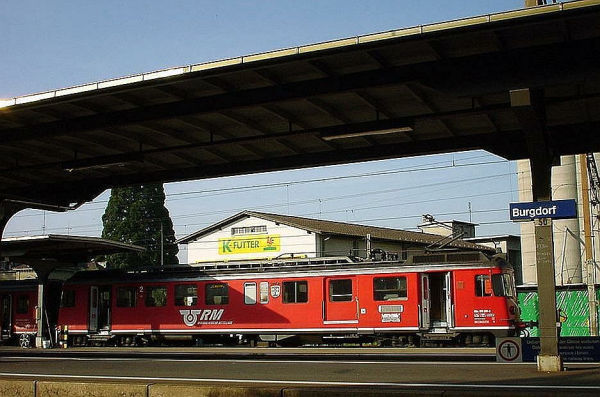
This motorwagon was of the type BDe 576. They were older trains than the NPZ model shown above. These trains were used by both EBT and VHB before they
merged into RM. There were initially three of these motorwagons and they were from the year 1966. One was later sold to OeBB Oensingen-Balsthal-Bahn,
one to SOB Südostbahn and the last one in 2005 to the Club del San Gottardo, which is a club that restores and saves historic trains.
Picture from Burgdorf 14.10.2001 by Ilkka Siissalo.
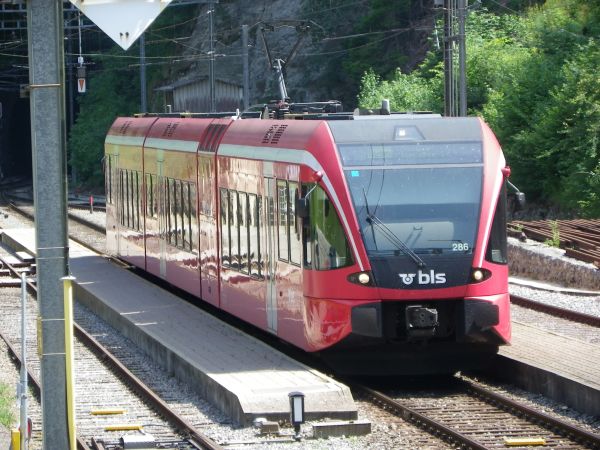
These trains were the newest ones of RM Regionalbahn Mittelland and they were ordered quite shortly before BLS bought the whole company RM. Here we
see this Stadler GTW 2/8 train still in RM's red livery, with just a new white BLS sticker on its front. Throughout the time that BLS owned these
trains BLS did not bother to repaint them in their own colours. I guess the reason was that there were only a few of these trains at BLS and they
thought that they'd rather get rid of them as it is fairly expensive to maintain a very small series. BLS then finlally sold all these GTW trains
to SBB which already had similar ones in use at SBB's daughter company Thurbo. But as it was, even SBB then continued to use some of these trains
in their original red livery. Now in 2023 SBB states that they want to scrap all these trains.
Picture from the small station of Gänsbrunnen (Goose well) 10.7.2010 by Ilkka Siissalo.
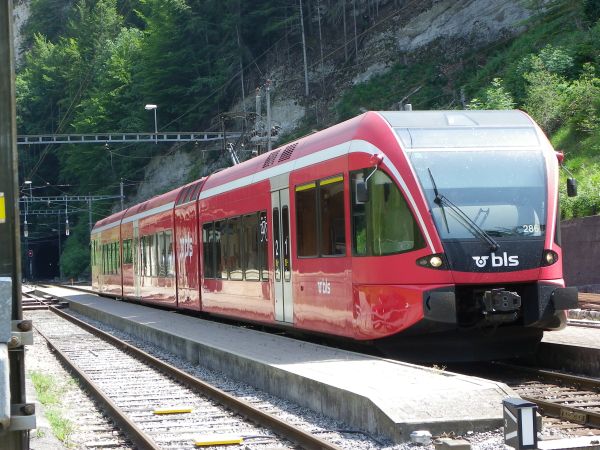
A closer look at the same Stadler GTW 2/8 train as above. Note that when the company BLS took over RM Regionalbahn Mittelland, BLS also proceeded
to use RM's existing logo as the new logo of the whole BLS group.
Picture from the small station of Gänsbrunnen 10.7.2010 by Ilkka Siissalo.
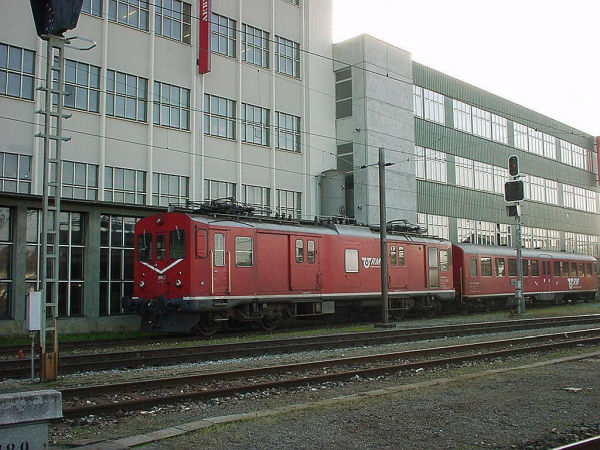
This train was old already at the time when this picture was taken. It was the De 586 no.267 (formerly De 4/4). These motorwagons were built originally in
1932-33 and they used to have all wooden chassises. They were thoroughly rebuilt in 1980-81 and they got by then the metal chassis that we can see. At the time
when this photo was taken, this oldie was no longer used in regular traffic, but just kept as a reserve, should some of the more modern EMU trains fail
for some reason. Originally there were four of these motorwagons, all with wooden chassises.
Picture of RM De 586 no.267 from Burgdorf 14.10.2001 by Ilkka Siissalo.
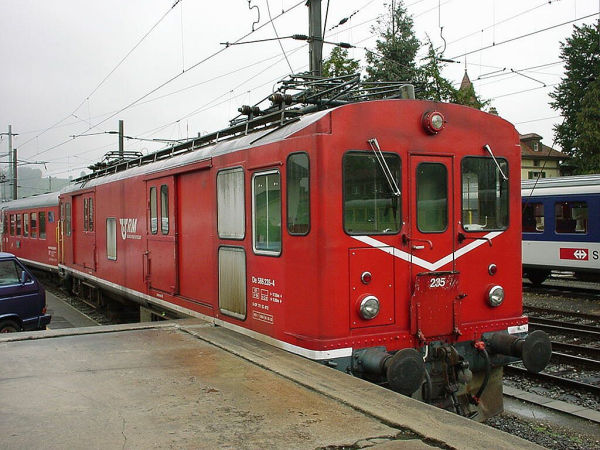
A similar oldie, this is the De 586 no.235. Originally with a wooden chassis, but here rebuilt and redesigned in the style of the 1980s.
Picture from Huttwil 1.9.2002 by Ilkka Siissalo.
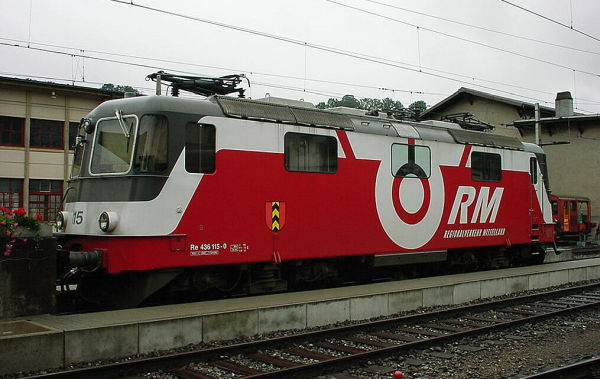
RM's electric locomotive Re 436 no.115 was a former SBB Re 4/4 II from the sixties. After the company RM was dissolved, the machine ended up at
Crossrail and after Crossrail suspended all its operations, the machine went on to another private operator. It has been in many different colours,
but this colouring was maybe the prettiest of them all.
Picture from Huttwil 1.9.2002 by Ilkka Siissalo.
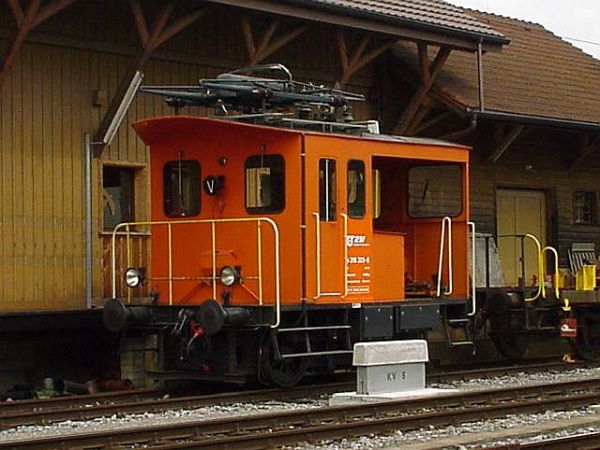
This very small electric shunter locomotive was classed as an "electric tractor" as class Te 216 I. It came to Regionalverkehr
Mittelland originally from the company VHB, Vereinigte Huttwil-Bahnen (united railroads of Huttwil) which then was fusioned
into EBT Emmental-Burgdorf-Thun-Bahn, which was later fusioned with RM and then finally with BLS Group. The small locomotive
is presumably from the year 1944. Since 2006 it has now been with the association VDBB, Verein Dampfbahn Bern (association
steam locomotive Bern).
Picture from Burgdorf 20.10.2001 by Ilkka Siissalo.
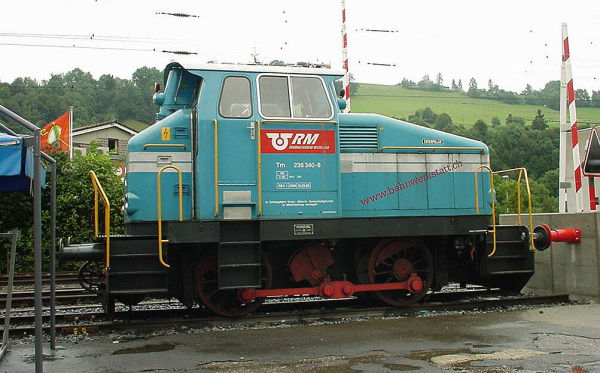
This small Henschel diesel locomotive Tm 236 no.340 was used by RM to move wagons at their depot.
Picture from Zell 1.9.2002 by Ilkka Siissalo.
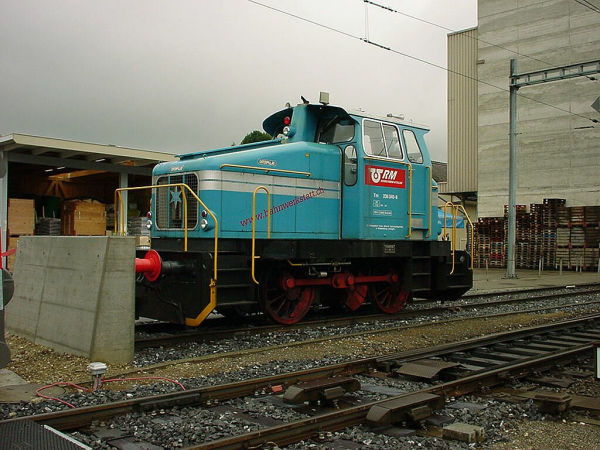
The same Henschel diesel seen from the other direction.
Picture from Zell 1.9.2002 by Ilkka Siissalo.
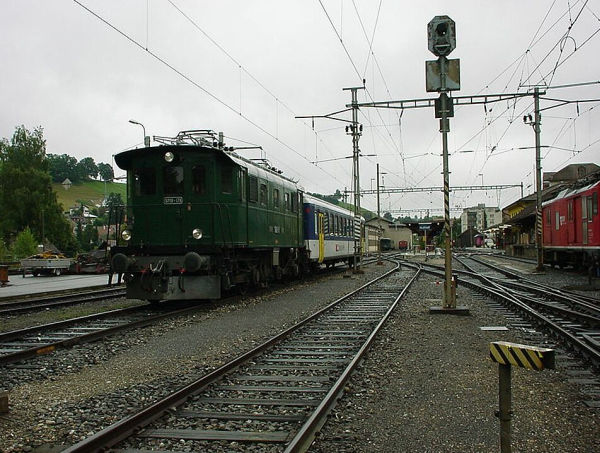
A historic old electric locomotive of RM, the Be 4/4 no.171 (later Be 416 no.171). It is a former machine of the company SMB. It's from the year 1932.
It was later in the year 2000 sold to a private person.
Picture from Huttwil 1.9.2002 by Ilkka Siissalo.
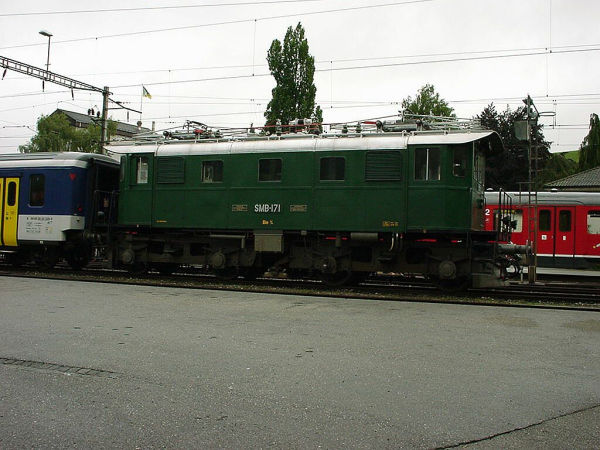
The same old Be 4/4 no.171 as above, here seen from its side.
Picture from Huttwil 1.9.2002 by Ilkka Siissalo.
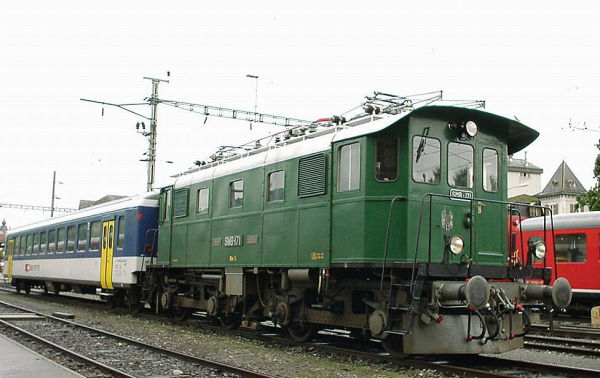
Still the same old Be 4/4 no.171 as above.
Picture from Huttwil 1.9.2002 by Ilkka Siissalo.
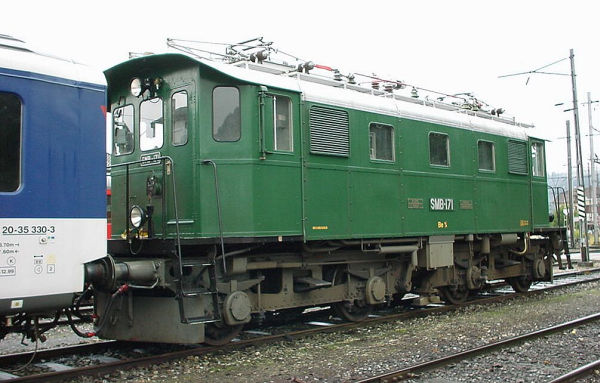
And still the same old Be 4/4 no.171 as above.
Picture from Huttwil 1.9.2002 by Ilkka Siissalo.
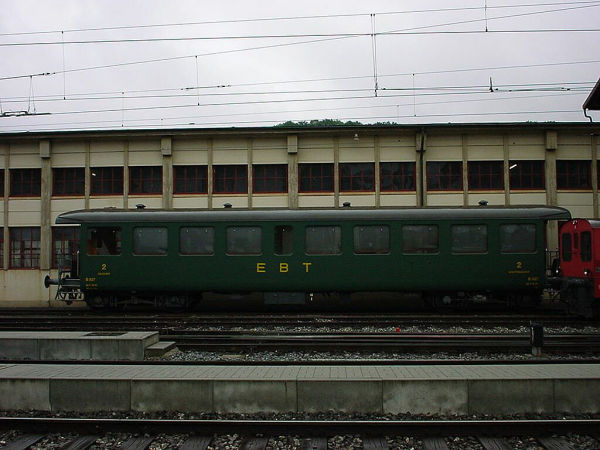
An old coach, so called Seetalwagen of the former EBT, which later became part of RM and still later BLS.
Picture from Huttwil 1.9.2002 by Ilkka Siissalo.
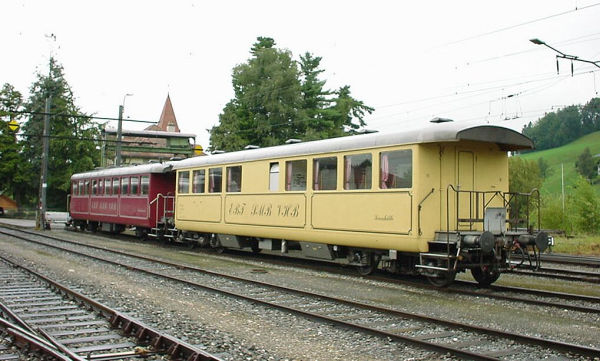
Two more old Seetalwagen coaches. These were used in 2002 in touristic nostalgic trains especially with the steam locomotives of RM.
Picture from Huttwil 1.9.2002 by Ilkka Siissalo.
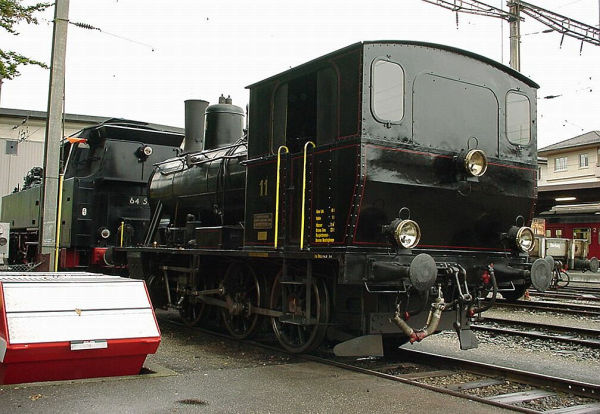
These were the two steam locomotives which RM owned in 2002. The small locomotive in the front is Ed 34 no.11 from 1908. The one behind is an old
German locomotive of the German class Br 64.
Picture from Huttwil 1.9.2002 by Ilkka Siissalo.
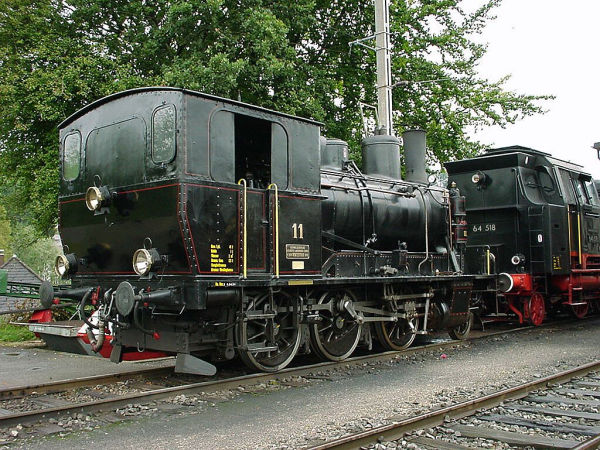
The same two steam locomotives seen from the other side.
Picture from Huttwil 1.9.2002 by Ilkka Siissalo.

